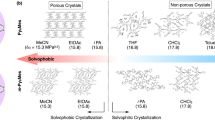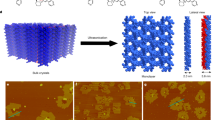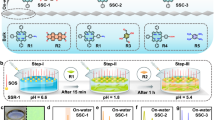Abstract
Self-assembly of planar molecules on a surface can result in the formation of a wide variety of close-packed or porous structures. Two-dimensional porous arrays provide host sites for trapping guest species of suitable size. Here we show that a non-planar guest species (C60) can play a more complex role by promoting the growth of a second layer of host molecules (p-terphenyl-3,5,3″,5″-tetracarboxylic acid) above and parallel to the surface so that self-assembly is extended into the third dimension. The addition of guest molecules and the formation of the second layer are co-dependent. Adding a planar guest (coronene) can displace the C60 and cause reversion to a monolayer arrangement. The system provides an example of a reversible transformation between a planar and a non-planar supramolecular network, an important step towards the controlled self-assembly of functional, three-dimensional, surface-based supramolecular architectures.
This is a preview of subscription content, access via your institution
Access options
Subscribe to this journal
Receive 12 print issues and online access
$259.00 per year
only $21.58 per issue
Buy this article
- Purchase on Springer Link
- Instant access to full article PDF
Prices may be subject to local taxes which are calculated during checkout




Similar content being viewed by others
References
Bartels, L. Tailoring molecular layers at metal surfaces. Nature Chem. 2, 87–95 (2010).
Elemans, J. A. A. W., Lei, S. B. & De Feyter, S. Molecular and supramolecular networks on surfaces: from two-dimensional crystal engineering to reactivity. Angew. Chem. Int. Ed. 48, 7298–7332 (2009).
Barth, J., Costantini, G. & Kern, K. Engineering atomic and molecular nanostructures at surfaces. Nature 437, 671–679 (2005).
Adisoejoso, J. et al. Two-dimensional crystal engineering: a four-component architecture at a liquid–solid interface. Angew. Chem. Int. Ed. 48, 7353–7357 (2009).
Chen, W. et al. Two-dimensional pentacene: 3,4,9,10-perylenetetracarboxylic dianhydride supramolecular chiral networks on Ag(111). J. Am. Chem. Soc. 130, 12285–12289 (2008).
Blunt, M. O. et al. Random tiling and topological defects in a two-dimensional molecular network. Science 322, 1077–1081 (2008).
Theobald, J. A., Oxtoby, N. S., Phillips, M. A., Champness, N. R. & Beton, P. H. Controlling molecular deposition and layer structure with supramolecular surface assemblies. Nature 424, 1029–1031 (2003).
Stepanow, S. et al. Surface-assisted assembly of 2D metal–organic networks that exhibit unusual threefold coordination symmetry. Angew. Chem. Int. Ed. 46, 710–713 (2007).
Tahara, K. et al. Two-dimensional porous molecular networks of dehydrobenzo[12]annulene derivatives via alkyl chain interdigitation. J. Am. Chem. Soc. 128, 16613–16625 (2006).
Griessl, S. J. H. et al. Room-temperature scanning tunneling microscopy manipulation of single C60 molecules at the liquid–solid interface: playing nanosoccer. J. Phys. Chem. B 26, 11556–11560 (2004).
Madueno, R., Raisanen, M. T., Silien, C. & Buck, M. Functionalising hydrogen-bonded surface networks with self-assembled monolayers. Nature 454, 618–621 (2008).
Ivasenko, O. et al. Supramolecular assembly of heterocirculenes in 2D and 3D. Chem. Commun. 1192–1194 (2009).
Schull, G. et al. Selectivity of single-molecule dynamics in 2D molecular sieves. Adv. Mater. 18, 2954–2957 (2006).
Wahl, M., Stohr, M., Spillmann, H., Jung, T. A. & Gade, L. H. Rotation–libration in a hierarchic supramolecular rotor–stator system: Arrhenius activation and retardation by local interaction. Chem. Commun. 1349–1351 (2007).
Stepanow, S. et al. Steering molecular organization and host–guest interactions using two-dimensional nanoporous coordination systems. Nature Mater. 3, 229–233 (2004).
Wu, D., Deng, K., He, M., Zeng, Q. & Wang, C. Coadsorption-induced reconstruction of supramolecular assembly characteristics. ChemPhysChem 8, 1519–1523 (2007).
Blunt, M. et al. Directing two-dimensional molecular crystallisation using guest templates. Chem. Commun. 2304–2306 (2008).
Li, M. et al. Site-selective fabrication of two-dimensional fullerene arrays by using a supramolecular template at the liquid–solid interface. Angew. Chem. Int. Ed. 120, 6819–6823 (2008).
Zhou, H. et al. Frustrated 2D molecular crystallization. J. Am. Chem. Soc. 129, 13774–13775 (2007).
Keeling, D. L., Humphry, M. J., Moriarty, P. & Beton, P. H. Attractive mode manipulation of covalently bound molecules. Chem. Phys. Lett. 366, 300–304 (2002).
Samorì, P., Severin, N., Simpson, C. D., Müllen, K. & Rabe, J. P. Epitaxial composite layers of electron donors and acceptors from very large polycyclic aromatic hydrocarbons. J. Am. Chem. Soc. 124, 9454–9457 (2002).
Griessl, S. J. H. et al. Incorporation and manipulation of coronene in an organic template structure. Langmuir 20, 9403–9407 (2004).
Acknowledgements
We thank the UK Engineering and Physical Sciences Research Council for financial support under grant EP/D048761/1. M.S. thanks the European Research Council for an Advanced Grant. N.R.C. acknowledges the receipt of a Royal Society Leverhulme Trust Senior Fellowship.
Author information
Authors and Affiliations
Contributions
M.O.B. and J.C.R. acquired the STM data, M.O.B. performed the MD simulations, M.C.G, X.L., M.S. and N.R.C. developed the synthetic route for the TPTC molecule, M.O.B. and P.H.B. analysed the data, M.O.B., N.R.C. and P.H.B. conceived and coordinated the experimental work and M.O.B., N.R.C. and P.H.B. co-wrote the paper.
Corresponding authors
Ethics declarations
Competing interests
The authors declare no competing financial interests.
Supplementary information
Supplementary information
Supplementary information (PDF 1185 kb)
Rights and permissions
About this article
Cite this article
Blunt, M., Russell, J., Gimenez-Lopez, M. et al. Guest-induced growth of a surface-based supramolecular bilayer. Nature Chem 3, 74–78 (2011). https://doi.org/10.1038/nchem.901
Received:
Accepted:
Published:
Issue Date:
DOI: https://doi.org/10.1038/nchem.901
This article is cited by
-
Toward conformational identification of molecules in 2D and 3D self-assemblies on surfaces
Communications Chemistry (2023)
-
Extending on-surface synthesis from 2D to 3D by cycloaddition with C60
Nature Communications (2023)
-
Dependence of the surface-assisted fullerene-based complex structure on the template molecule design
Nano Research (2019)
-
Pyridine-induced interfacial structural transformation of tetraphenylethylene derivatives investigated by scanning tunneling microscopy
Nano Research (2018)
-
Templated bilayer self-assembly of fully conjugated π-expanded macrocyclic oligothiophenes complexed with fullerenes
Nature Communications (2017)



